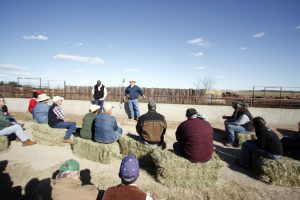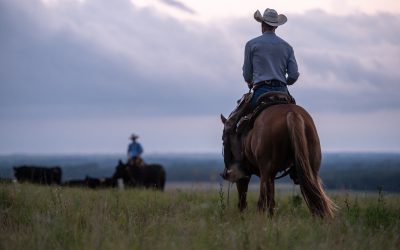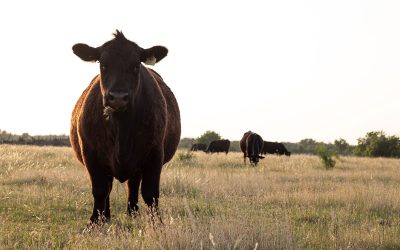An outlook with a view
March 25, 2011
With a stiff spring wind whopping against the sides of the big event tent, Mike couldn’t help but make a joke to start the afternoon off. “All I can say is, if this tent starts to go, everybody better grab a rope and hold tight. I suppose it’s kind of like the cattle business — we don’t know which direction it’s going to go, but if we all hang on together we’ll be in for a heck of a ride!”
Wednesday I had the opportunity to travel out to the Collinge Ranch near Hamilton, KS with about 150 of my closest friends for a field day, Backgrounding for Quality. Our team at CAB got together with the folks from Pfizer Animal Health and the Pratt Feeders group to host the half-day educational event for cattlemen and women focused on the stocker/backgrounding phase. Now, I’ve been to some beautiful convention centers — take our Annual Conference in beautiful Puerto Rico, for example. But in my mind, not a whole lot beats a “meeting room” with a view like this, wind or not:

Attendees had a chance to take a hands-on look around Mike’s ranch and share the ideas and questions that come with seeing how another guy gets to the same end point. I heard a lot of great discussions, ranging from vaccination programs that work in different scenarios, how to implement age and source verification programs, how processing facilities are set up and utilized, how to spot a sick calf early and on and on.

I’ll share some more of those conversations and ideas later this week as I have time to dig through those notes. We certainly had a nice view of Mike’s family ranch from these hay bale seats, but one of the key speakers for the event had another view to share. Dr. Derrell Peel from the Oklahoma State University gave a big-picture overview of cattle markets, international trade and feedstuff markets. Here are a few highlights I jotted down:
State of the industry:
-
Feeder cattle supplies were 3% lower on Jan. 1 than the very low number that we had before then. Dr. Peel emphasized: “We are extremely tight on cattle. And we still don’t have any data that tells us that we are saving heifers. So we know feeder cattle supplies are very tight and are going to be that tight for a while. I think we’re looking at 3-5 years, at least, before we fundamentally change herd numbers.”
-
How “real” are these recent market prices? “Fed cattle have increased relative to feeder cattle relative to the calves and looking at boxed beef — All these prices have moved together. That’s what I look for to see how “real” these prices are. They all make some sense together, so that tell me these prices are proved by real market fundamentals. It always makes to nervous, of course, when prices come on that fast that they’ll go away that fast. But this really is something that has been building for a long time. The fundamentals that got us to this point have been building for the past 15 years, and these prices are here to stay.”
Feed markets:
-
“Corn prices are probably not coming down any time soon — we’re in a whole new world. It’s not a supply problem. We’ve continued to produce record levels, but the increased total demand for this product has made us barely able to meet our needs.”
-
Who wants it worse? “The market will make you choose not to buy it if our supplies get too tight. We spent 40-50 years with cheap corn; the average price of corn was 2.25 over the past 25 years. I’m not sure what’s it’s going to average going forward, but it’s going to be at least twice that, if that three times.” Energy needs are not going to go away, no matter that policy changes are made. It’s here to stay as a competitor for corn, Dr. Peel said.
-
“The beef industry can survive higher corn prices better than pork or poultry. We spent 50 years in this country trying to figure out how to allow cattle to eat the most cheap grain as they could, and that was the right thing to do in that environment. I think in the next 20-30 years, this industry is going to spend a lot of time to raise high-quality beef using the least amount of grain. That means every one of you in this room [as stocker operators] has a tremendous opportunity, because it’s going to put an emphasis back on forage.
With that news, Dr. Peel certainly had a market outlook with a good view to share with stocker cattlemen. He said was glad to be presenting to a stocker audience rather than feedlots, but we know that a focus on efficient gain can help those guys out with these crazy corn prices, too.
Stay tuned later today and over the weekend for a few more highlights from the field day, including a presentation by Janet Riley of the American Meat Institute.
You may also like
Progress from small steps
Every day is a chance to learn and get better. Thousands of others like my new friends in Alabama are taking steps to meet the shifts in consumer demand, and to know more. Small steps in the right direction can start now. Even if it’s just recording a snapshot of where you are today, a benchmark for tomorrow.
Not perfect, but working to get better
The CAB Cattleman Connection team heard its name called more than once in the virtual ceremonies, and each time came a sense of personal accomplishment, but even better: confirmation that we’re getting better at our craft. I hope that means we’re doing a better job for you.
Beefed up findings
Frank Mitloehner presents his findings on the animal ag sector’s impact on global warming. He explains how cattle counterbalance other fossil fuel sectors, proving that cattle are a solution and not a threat.




